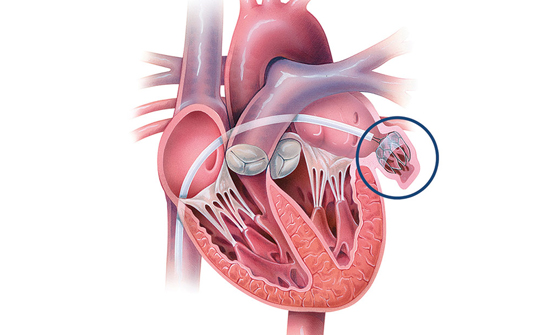Left atrial appendage closure is a surgical or minimally invasive procedure to seal off your left atrial appendage (LAA), a small sac in the muscle wall of your left atrium (top left chamber of your heart). Removing it or closing it off can reduce your risk of stroke and eliminate the need to take blood-thinning medication.
Studies have shown that, among people with atrial fibrillation who don’t have valve disease, most of the blood clots that happen in the left atrium start in the LAA.
It’s unclear what function, if any, the left atrial appendage performs. Your heart can continue to do its job with a closed left atrial appendage.
Normal hearts contract with each heartbeat, and the blood in your left atrium and LAA is squeezed out of your left atrium into your left ventricle (bottom left chamber of the heart).
In someone who has atrial fibrillation, the electrical impulses that control the heartbeat don’t travel in an orderly way through your heart. Instead, many impulses begin at the same time and spread through the atria. The fast and chaotic impulses don’t give your atria time to contract and/or effectively squeeze blood into your ventricles.
Because the left atrial appendage is a little pouch, blood collects there and can form clots in the LAA and atria. When your heart pumps out blood clots, they can cause a stroke. People with atrial fibrillation are three to five times more likely to have a stroke than the general population.

If you’re at risk of developing blood clots in your left atrium/left atrial appendage, your healthcare provider may recommend a procedure to seal off your LAA. This is an alternative to taking a blood thinner like warfarin (Coumadin or Jantoven) to reduce your risk of stroke from atrial fibrillation.
Many people have concerns about, or dislike, taking warfarin. Some of the reasons for this are:
Other medications — dabigatran and rivaroxaban — are available for people with atrial fibrillation who don’t have heart valve disease. However, some people have concerns and problems with these medications, such as:
LAA closure reduces the stroke risk associated with atrial fibrillation. But, it doesn’t treat the AFib itself. Left atrial appendage closure can benefit people who need heart surgery and also have atrial fibrillation. The procedure is also helpful for those who have atrial fibrillation (but no other problems that require heart surgery) and choose to have a Maze procedure for atrial fibrillation.
Researchers who looked at more than 10,000 cardiac surgery records found that 37% of people had a left atrial appendage closure during their surgery.
More than 150,000 people have received the WATCHMAN device that blocks the left atrial appendage’s opening.
After your surgery or minimally invasive procedure, you may:
People who get a left atrial appendage closure can: